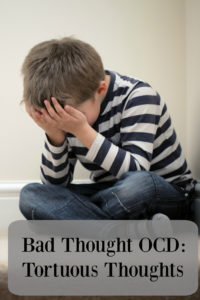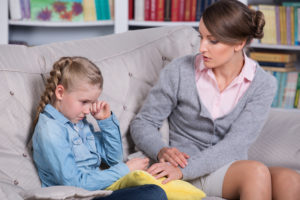Bad Thought OCD is an atypical presentation of Obsessive Compulsive Disorder.
While Bad Thought OCD is not typical OCD it is likely more common than we realize because it goes undiagnosed.
In standard Obsessive Compulsive Disorder there are fears/concerns which we call obsessions. Those fears then spark Compulsions, which are actions taken that feel out of control to the person performing them. The purpose of these compulsions is to quiet the angst in the mind that is being caused by the obsessive thoughts.
In Bad Thought OCD there often appears to be no Compulsion. The child may just seem upset or to be experiencing conflicting feelings that are confusing them. In the absence of ritualized behaviors it can be difficult to recognize OCD.
Bad Thought OCD can be extremely difficult for the child experiencing it. It is no less intense than other more typical presentations of OCD and at times the child may feel more trapped with the suffering because there is no compulsive outlet that quiets the anxiety.
To illustrate with and example if the obsessive thought is regarding safety of the home and the door being locked the child may can find temporary relief by ritualized methods of checking the door.

Upset problem child with head in hands sitting on staircase
In a case of Bad Thought OCD the child’s obsessive symptoms present in the following ways.
1. Thoughts about bad things happening to themselves and people that they love.
2. Thoughts about hating, disliking, or harming people and things that they love.
3. Anguish in these thoughts because they are experiencing them as first person thoughts. “I hate Bobby.” Which is immediately followed by a sense of remorse, suffering, and emotional pain because Bobby is their best friend, they love him, and they are not even mad at him at the moment.
4. Sometimes the thoughts are very morbid and graphic. They are described as being very real, not unlike vivid nightmares. These images can be very disturbing.
The reason that Bad Thought OCD is overlooked at times is that the compulsions may be hidden or subtle. The other reason is that sometimes the obsessions are dismissed as being fluctuations in the child’s opinions, bad dreams, anger, or manipulation.
The compulsions to watch for in Bad Thought OCD
1. Confession: The child is experiencing thoughts that are upsetting them greatly. They are experiencing these thoughts as something that they really truly feel even though it is a direct contradiction to how they actually feel. The child then feels terrible about this and extremely distressed. They may hide this for a while but then find that confessing when these thoughts occur releases them. The child may then begin compulsively confessing each and every one of these intrusive thoughts. This often means stopping what they are doing to share the thought with the caretaker.
2. Seeking Reassurance: The child may also seek reassurance that the person whom they are confiding their obsessive thoughts knows that they do not really think that. They may seek to hear the opposite of the thought that harmed them stated to them for comfort.
So, if the child is playing with their best friend Bobby and having a very good time their brain may suddenly send a message to them that they hate Bobby. That child may then go to the caregiver in the middle of playing to release that thought. The caregiver could take in that thought and reflect back to the child a reassurance that they know how much he loves Bobby. The child then returns to playing happily.
Another way that the child may seek reassurance is in situations where the bad thoughts come in images of doing harm to others or that harm is going to come to loved ones. The reassurance sought in this situation may be that the child is seeking a promise from the caregiver that nothing bad is going to happen and that they will not hurt anyone.
3. Remorse-Efforts to Make Right: The child is experiencing thoughts that are in direct contradiction with how they truly feel about everyone and everything in their life that they love. These thoughts leave them feeling guilty. Sometimes rituals develop of making it right. Some examples may include apologies, picking flowers for their mother, hugging their sister, prayers for others well being, superstitions or wishes.
Some of these gestures sound lovely. Who wouldn’t want to hear their child wishing for the well being of others and hugging their sister a few times a day. The acts may be lovely, but if they are stemming from a deep sense of remorse and suffering then the core problem needs to be addressed.
Bad Thought OCD is truly torturous in the child’s experience. It may seem more mild from the perspective of an onlooker but that is because it is trapped inside swirling in the child’s heart and mind. Bad Thought OCD turns everyone and everything the child loves into a liability and picks at these sources of comfort. The result leaves the child feeling less comfort, guilt, confusion, sorrow, and hurt. They begin to feel that they are hurting those they love and that they are a bad person. It can be isolating, confusing, and extremely emotionally painful.
When a child is experiencing these thoughts it is extremely important that the family provide support and encouragement consistently. If the child is coming with compulsive need to confess or get reassurance they need the confidant to provide a consistently supportive response in order to feel a relief. The compulsion in this case is to tell their mom that they had a horrible thought that hurt them and in return they need to hear reassurance. This can be difficult when they have done so 50 times in a day. It can be tempting to tell them to knock it off, but they can’t. It is really sort of like kissing 50 different boo boo’s they have gotten in a day.
That comparison is helpful in another way. Try to imagine how banged up and worse for wear a child would feel after getting 50 boo boo’s in a single day…what if that 50 occurred before lunch and they knew more were to come. That is emotional exhaustion worthy of serious love and support. That love and support needs to be unwavering even if the confessed thought is mean or hurtful and about the parent/caregiver to whom they are confessing or seeking reassurance. Yes. If the compulsion is to confess when they have bad thoughts and they are confessing to mommy, that means mommy is going to hear when the thought was “I hate mommy.” If the thought is “I want mommy to die.” Mommy is going to hear that as well.
The important thing is to remember Bad Thought OCD is about the child’s mind sending them messages that are contradictory to the thoughts and feelings they hold most dear. Often the Bad Thoughts occur while the child is actively thinking something positive. So if the child is telling mommy that they are having a thought that they hate mommy and they are visually upset by this it may help to keep in mind that the thought is distressing to them BECAUSE that is not how they truly feel.
Maintaining a supportive and reassuring stance in the face of hurtful disclosures and repetitive seeking of reassurance is very important. To read more about supporting and encouraging a child with OCD click here. Beyond the need for consistent support the child can benefit from being given some skills to understand the confusion that is occurring in their mind.

Child psychologist with a little girl, a child is crying
We do this by encouraging the child to see the OCD as being outside of themselves. They need to distance themselves from these thoughts. The thoughts are distressing and hurtful because they are not thoughts that they agree with. Children are encouraged to picture a little monster that is their OCD. They are usually asked to describe and draw this little monster. This little monster is to be seen as a mean little trickster who is playing tricks on them with these thoughts. Below is an image of a book that helps with this technique.

The terrific thing about this technique is that it makes it much easier for the child to deal with the contradictory thoughts in their mind. It helps them to address the sense of guilt and confusion they are having about what they really think and feel. The child puts the thoughts that are distressing them into the hands of the little monster each time they pop into their mind. The child is encouraged to fight back against the monster by giving him back his bad thoughts and fears. For more about treating child OCD click here.
A couple of things can be difficult with this strategy. First of all, the child needs to visualize a monster that is not so cute and cuddly that they want to view it as a friend. That monster always needs to not be so fearsome that they do not feel empowered to challenge it’s trickery. This monster is to represent their OCD and we do not want it to seem too intimidating or insurmountable.
Second, if the child has difficulty with visualization skills or is too young to understand and effectively do this it may not work. This young age was a significant factor for my son and required the use of a visual work around. For us we fortunately stumbled upon Disney’s Fantasmic at just the right moment. The plot line of the story is that Mickey has happy dreams and wacky dreams. Those dreams become dark and scary. He then has to fight the bad dreams away to regain control. By easily replacing dreams with thoughts it functioned quite nicely as a visualization tool for my son when he was 5 and 6 years old.
Over time a child’s experience of OCD can shift. A period of Bad Thought OCD can morph into a more classic OCD presentation. For a lengthier discussion of OCD presentation in children click here.
Quiz for parents who are wondering if their child might have OCD and need treatment. Click Here

Shannon
Latest posts by Shannon (see all)
- Social Anxiety: More Than Shy - July 10, 2016
- 3 BIG Reasons To Give Children Specific Meaningful Praise - June 27, 2016
- Protecting Children From Sexual Predators: Safety Without Paranoia - June 6, 2016


This is a great website. So informative and well laid out. I have a 6 year old daughter who has bad thought OCD and we are meeting with a therapist next week. I was wondering what should we say then she says “the bad thoughts make me feel like I really want to do these things?” “I feel like I’m actually going to hurt my brother” what should our response be?
So glad to be of help. Change takes time but understanding and support helps so much along the way. My son is almost 12 now. His OCD has morphed over time to a more classic OCD. I believe over time as his mind matured his experience changed. He has good cycles and bad cycles. Bad cycles are often triggered by a loss of structure or routine such as the end of a school year and start of Summer break.